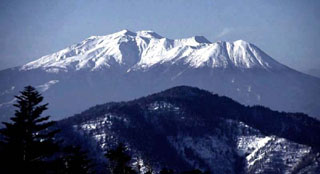Report on Ontakesan (Japan) — November 2003
Bulletin of the Global Volcanism Network, vol. 28, no. 11 (November 2003)
Managing Editor: Edward Venzke.
Ontakesan (Japan) Persistent long-term seismicity and occasional small white plumes
Please cite this report as:
Global Volcanism Program, 2003. Report on Ontakesan (Japan) (Venzke, E., ed.). Bulletin of the Global Volcanism Network, 28:11. Smithsonian Institution. https://doi.org/10.5479/si.GVP.BGVN200311-283040
Ontakesan
Japan
35.893°N, 137.48°E; summit elev. 3067 m
All times are local (unless otherwise noted)
Seismic activity at On-take has been ongoing in recent years. Data provided by the Japan Meteorological Agency indicates that from January 2000 through April 2003 an average of 140 volcanic earthquakes per month were recorded by the local seismic station. The number usually ranged between 90 and 200 each month. Activity was higher in July 2001 (300 total events, with 65 on the 1st) and December 2002 (206 total events, with 63 on the 4th). No volcanic tremor was registered. White plumes rising no higher than 300 m were observed once in June 2000 and March 2001, and more frequently during November 2001-January 2002. Small white plumes were seen once per month in September-November 2002 and January-March 2003.
Geological Summary. The massive Ontakesan stratovolcano, the second highest volcano in Japan, lies at the southern end of the Northern Japan Alps. Ascending this volcano is one of the major objects of religious pilgrimage in central Japan. It is constructed within a largely buried 4 x 5 km caldera and occupies the southern end of the Norikura volcanic zone, which extends northward to Yakedake volcano. The older volcanic complex consisted of at least four major stratovolcanoes constructed from about 680,000 to about 420,000 years ago, after which Ontakesan was inactive for more than 300,000 years. The broad, elongated summit of the younger edifice is cut by a series of small explosion craters along a NNE-trending line. Several phreatic eruptions post-date the roughly 7300-year-old Akahoya tephra from Kikai caldera. The first historical eruption took place in 1979 from fissures near the summit. A non-eruptive landslide in 1984 produced a debris avalanche and lahar that swept down valleys south and east of the volcano. Very minor phreatic activity caused a dusting of ash near the summit in 1991 and 2007. A significant phreatic explosion in September 2014, when a large number of hikers were at or near the summit, resulted in many fatalities.
Information Contacts: Volcanological Division, Japan Meteorological Agency (JMA), 1-3-4 Ote-machi, Chiyoda-ku, Tokyo 100, Japan (URL: http://www.jma.go.jp/).

